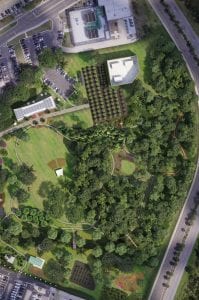New Arboretum Master Plan Unveiled

The UCF Arboretum started as a 10-acre site in 1983 on what was then the edge of campus. Over the years several parcels were added to bring the Arboretum to its current size of 82 acres, but the original site remains the core area for the Arboretum program. It contains Arboretum facilities such as the main office, located in a 1,000 square-foot portable building, a glass greenhouse with adjacent propagation shelter, and the newly expanded community garden.
The Arboretum also contains several notable natural features, including a large drainage ditch that has been restored over the past decade into a beautiful, native riparian habitat. There is a small wooded wetland that has nature trails and contains an original boardwalk that was built by our founding director, the late Hank Whittier, and his students. The boardwalk is one of the few remaining original features of the core Arboretum site, and we officially dedicated it to Dr. Whittier during our enjoyable and successful friend-raising event in March.
The original Arboretum site would not be recognizable to anyone who visited before 2004, at which time it was nearly all wooded and was filled with a remarkable collection of plants that Dr. Whittier had accumulated over his 20 years as director. Virtually all of the original native vegetation and Whittier’s beautiful collection were destroyed during a series of hurricanes in 2004, just after he had retired. The next Director, Dr. Martin Quigley, was faced with the difficult decision to clear the site, and start over with a new vision for world gardens, which he started to build in 2005.
Unbeknownst to Dr. Quigley, the original Arboretum site was part of a wetland conservation easement that strictly limited the types of activities and changes that could take place there. The clearing of the land, introduction of gardens, building of gravel walkways, and construction of a wooden footbridge across the ditch—all these activities violated the terms of the easement. As a result, the University was required to remove these elements and restore the site to its original state.
In 2011, the University succeeded in having the conservation easement removed from the 7-acre Arboretum site by agreeing to put another 17-acre, more pristine wetland under a conservation easement. This change opened up the opportunity to redevelop the core Arboretum site. The vision for the site was to create an engaging, park-like setting with diverse ecological and horticulture features that allowed visitors to immerse themselves in the beauty and wonder of nature just a 5-minute walk from the center of campus.
Last year, leaders from the Arboretum and Landscape and Natural Resources came together to envision a new master plan for the Arboretum site. After coming up with the basic elements and layout of the plan, the staff worked with an architectural rendering and visualization firm, Artistic Visions, to produce a digital rendering of the site plan. This plan was unveiled to the public at the Arboretum friend-raising event in March. Its new elements include: a trail framework, amphitheater, specialty gardens, expanded tree canopy, a new footbridge over the ecologically-restored stream and a large plant nursery.
The Arboretum is thrilled to have this new road-map that will guide our efforts to transform the original Arboretum site from its already beautiful setting into an even more wondrous, inspiring and enjoyable natural space. We hope you will join us in this exciting venture by continuing to support our program into the future.
